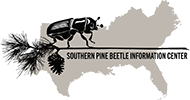Abstract All higher organisms are involved in symbioses with microbes. The importance of these partnerships has led to the concept of the holobiont, defined as the animal or plant with all its associated microbes. Indeed, the interactions between insects and symbionts...
2011-2020 Publications
Southern Pine Beetle (Coleoptera: Curculionidae: Scolytinae) Pheromone Component trans-Verbenol: Enantiomeric Specificity and Potential as a Lure Adjuvant
Abstract The southern pine beetle, Dendroctonus frontalis Zimmermann (Coleoptera: Curculionidae: Scolytinae) utilizes a multi-component aggregation pheromone to mediate mass-attacks and thereby colonize otherwise unsusceptible trees. Females produce the attractant...
Spatial Displacement of a Lure Component Can Reduce Catches of Two Nontarget Species During Spring Monitoring of Southern Pine Beetle
Abstract Local outbreak risk for the southern pine beetle, Dendroctonus frontalis Zimmermann (Coleoptera: Curculionidae), is forecast with a trapping survey conducted every spring throughout the southeastern United States. Traps baited with pine odors and components...
Southern Pine Beetle, Dendroctonus frontalis, Antennal and Behavioral Responses to Nonhost Leaf and Bark Volatiles
Abstract A growing body of evidence suggests that bark beetles detect and avoid release points of volatile compounds associated with nonhost species, and thus such nonhost volatiles may have potential utility in the management of bark beetles. We used a coupled gas...
Genetic Heterogeneity in a Cyclical Forest Pest, the Southern Pine Beetle, Dendroctonus frontalis, is Differentiated Into East and West Groups in the Southeastern United States
Abstract The southern pine beetle, Dendroctonus frontalis Zimmerman (Coleoptera: Curculionidae) is an economically important pest species throughout the southeastern United States, Arizona, Mexico, and Central America. Previous research identified population structure...
Ecology and Management of Bark Beetles (Coleoptera: Curculionidae: Scolytinae) in Southern Pine Forests
Abstract Bark beetles (Coleoptera: Curculionidae: Scolytinae) have been an important historic and current factor affecting pine forest production in the southern United States. Although tree mortality to bark beetles often detracts from forest management goals, the...
Molecular evidence of facultative intraguild predation by Monochamus titillator larvae (Coleoptera: Cerambycidae) on members of the southern pine beetle guild
Abstract The southern pine bark beetle guild (SPBG) is arguably the most destructive group of forest insects in the southeastern USA. This guild contains five species of bark beetles (Coleoptera: Curculionidae: Scolytinae): Dendroctonus frontalis, Dendroctonus...
Response of Dendroctonus frontalis Zimmerman and Dendroctonus mexicanus Hopkins to Two Semiochemical Lures in the Sierra Gorda of Queretaro, Mexico
Abstract A field study was conducted to evaluate the response of Dendroctonus frontalis and Dendroctonus mexicanus to two commercially available semiochemical lures (1) frontalin + α-pinene, (2) frontalin + blend of α-pinene and β-pinene + endobrevicomin, and to know...
Assessing landowner preferences for forest management practices to prevent the southern pine beetle: An attribute-based choice experiment approach
Abstract Southern pine beetle (SPB) prevention cost-share programs provide a financial incentive to private forest landowners in exchange for undertaking forest management practices that improve stand health. Healthy pine trees in low density stands offer the best...
